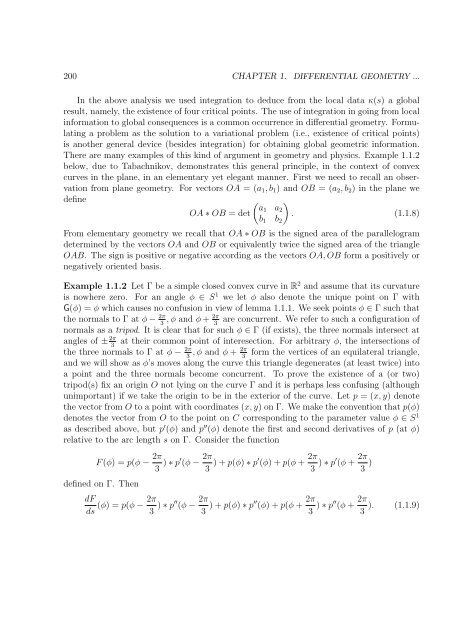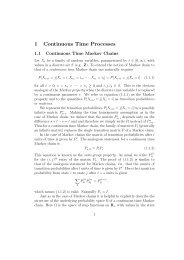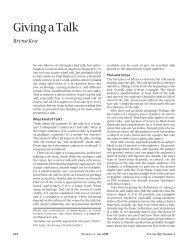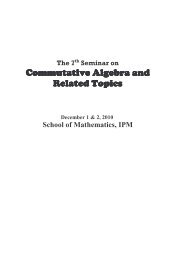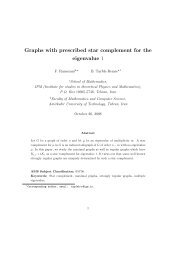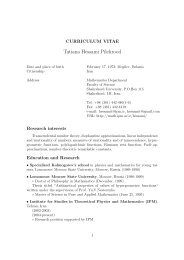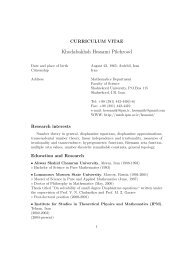Chapter 1 DIFFERENTIAL GEOMETRY OF REAL MANIFOLDS
Chapter 1 DIFFERENTIAL GEOMETRY OF REAL MANIFOLDS
Chapter 1 DIFFERENTIAL GEOMETRY OF REAL MANIFOLDS
You also want an ePaper? Increase the reach of your titles
YUMPU automatically turns print PDFs into web optimized ePapers that Google loves.
200 CHAPTER 1. <strong>DIFFERENTIAL</strong> <strong>GEOMETRY</strong> ...<br />
In the above analysis we used integration to deduce from the local data κ(s) a global<br />
result, namely, the existence of four critical points. The use of integration in going from local<br />
information to global consequences is a common occurrence in differential geometry. Formulating<br />
a problem as the solution to a variational problem (i.e., existence of critical points)<br />
is another general device (besides integration) for obtaining global geometric information.<br />
There are many examples of this kind of argument in geometry and physics. Example 1.1.2<br />
below, due to Tabachnikov, demonstrates this general principle, in the context of convex<br />
curves in the plane, in an elementary yet elegant manner. First we need to recall an observation<br />
from plane geometry. For vectors OA = (a1, b1) and OB = (a2, b2) in the plane we<br />
define<br />
<br />
a1 a2<br />
OA ∗ OB = det . (1.1.8)<br />
b1 b2<br />
From elementary geometry we recall that OA ∗ OB is the signed area of the parallelogram<br />
determined by the vectors OA and OB or equivalently twice the signed area of the triangle<br />
OAB. The sign is positive or negative according as the vectors OA, OB form a positively or<br />
negatively oriented basis.<br />
Example 1.1.2 Let Γ be a simple closed convex curve in R 2 and assume that its curvature<br />
is nowhere zero. For an angle φ ∈ S 1 we let φ also denote the unique point on Γ with<br />
G(φ) = φ which causes no confusion in view of lemma 1.1.1. We seek points φ ∈ Γ such that<br />
the normals to Γ at φ − 2π<br />
2π<br />
, φ and φ + are concurrent. We refer to such a configuration of<br />
3 3<br />
normals as a tripod. It is clear that for such φ ∈ Γ (if exists), the three normals intersect at<br />
angles of ± 2π at their common point of interesection. For arbitrary φ, the intersections of<br />
3<br />
the three normals to Γ at φ − 2π<br />
2π<br />
, φ and φ + form the vertices of an equilateral triangle,<br />
3 3<br />
and we will show as φ’s moves along the curve this triangle degenerates (at least twice) into<br />
a point and the three normals become concurrent. To prove the existence of a (or two)<br />
tripod(s) fix an origin O not lying on the curve Γ and it is perhaps less confusing (although<br />
unimportant) if we take the origin to be in the exterior of the curve. Let p = (x, y) denote<br />
the vector from O to a point with coordinates (x, y) on Γ. We make the convention that p(φ)<br />
denotes the vector from O to the point on C corresponding to the parameter value φ ∈ S1 as described above, but p ′ (φ) and p ′′ (φ) denote the first and second derivatives of p (at φ)<br />
relative to the arc length s on Γ. Consider the function<br />
F (φ) = p(φ − 2π<br />
3 ) ∗ p′ (φ − 2π<br />
3 ) + p(φ) ∗ p′ (φ) + p(φ + 2π<br />
3 ) ∗ p′ (φ + 2π<br />
3 )<br />
defined on Γ. Then<br />
dF<br />
2π<br />
(φ) = p(φ −<br />
ds 3 ) ∗ p′′ (φ − 2π<br />
3 ) + p(φ) ∗ p′′ (φ) + p(φ + 2π<br />
3 ) ∗ p′′ (φ + 2π<br />
). (1.1.9)<br />
3


